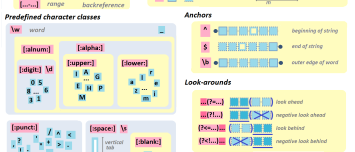Regexp - Non-printing characters
About
encoding non-printing characters
Articles Related
Encoding type
backslash
| Encoding | Description |
|---|---|
| \a | alarm, that is, the BEL character (hex 07) |
| \cx | “control-x”, where x is any character |
| \e | escape (hex 1B) |
| \f | formfeed (hex 0C) |
| \n | newline (hex 0A) |
| \p{xx} | a character with the xx property, see unicode properties for more info |
| \P{xx} | a character without the xx property, see unicode properties for more info |
| \r | carriage return (hex 0D) |
| \t | tab (hex 09) |
| \xhh | character with hex code hh |
| \ddd | character with octal code ddd, or backreference |
See the documentation of the regexp function.
Binary character
You can also use the binary character (in Unicode) (binary zero terminates a pattern):
